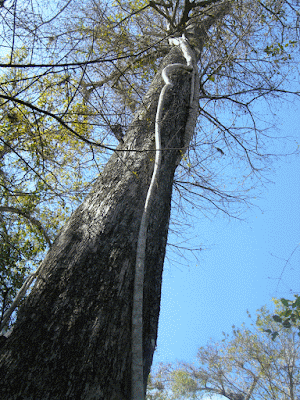I have been working hard on finishing pieces for a show in January, which means I 've been neglecting sketching and blogging. I'm taking a little time now trying to catch up for a while.
White mangrove, Laguncularia racemosa, and buttonwood, Conocarpus erectus, both bloomed in late July, and well into August. They are in the family Combretaceae, which also includes the black olive, sometimes used as a shade tree. My neighborhood in Miami was lined with these stately trees until Hurricane Andrew uprooted dozens - maybe hundreds - of them along with huge slabs of sidewalks.
White mangrove, obviously, is classified as a mangrove, but buttonwood, which lacks special adaptations to cope with highly saline, saturated, and oxygen-starved soils, is considered a "mangrove associate." Typically it will be the most landward, highest and driest species in a mangrove forest habitat. It often grows in mixed stands with the white mangrove. However, white mangrove requires at least moist soils, whereas buttonwood is very drought-tolerant.
 |
| White Mangrove, Laguncularia racemosa |
The presence of 2 bumps, one on each side of the petiole just beneath the leaf, is characteristic of the Combretaceae. They once were thought to excrete salt, but the general consensus now is that they are "extra-floral nectaries," glands outside the flowers that secrete nectar. It's possible that the reliable source of nectar attracts ants and wasps, which then protect the plant from leaf-eating insects. Only the new leaves of white mangrove produce nectar.(1)*
 |
| White Mangrove, Extra-floral Nectaries in Center of Illustration |
Another, really cool, feature of this plant family is the presence of "domatia" on the undersides of the leaves. "Domacium" is Latin for "house, home, etc." - think "domicile." A domatium on a plant is a pit, pouch, or tuft of hairs that serves as a residence for ants or tiny arthropods like mites. There probably is a symbiotic or mutualistic relationship between creature and leaf.
Under magnification the domatia on these 2 plants look like mini volcanos, with the crater being the home. They don't go all the way through the leaf, but do make slight bumps on the other side. In buttonwoods the domatia tend to be lined up along the midvein where secondary veins branch off. They are located about a quarter of an inch inside the outer margins on the white mangrove.
 |
| Domatia, Buttonwood on Left; White Mangrove on Right; Expanded View of Domatium on Right |
The white mangrove is primarily a "salt excretor," getting rid of salt through its leaves. Lenticels on the trunk help with air exchange in very wet situations, and it can send up "peg roots," like the pneumataphores of black mangroves, to aid in air exchange if it is inundated regularly.
White mangrove and black mangroves are the most salt-tolerant of our mangroves, able to survive in areas with salt concentrations as high as 40-50,000 ppm, but buttonwood is usually destroyed at concentrations of 40,000 ppm. (2)
At first glance, the idea that the red mangrove, which can grow directly in the salty water of estuaries, is the least salt-tolerant of the group seems counter-intuitive, at least to me. Actually, constant tidal flushing and freshwater runoff into these estuarine habitats reduce salinity in the red mangrove root zone. In fact, the red mangrove reaches its most luxurient growth along tidal rivers and even in freshwater swamps if it is not out-competed. White and black mangrove are flooded only intermittently, so salts accumulate in their soils.
The white mangrove gets its common name from its light-colored bark. The leaves are opposite, succulent, yellow-green and oval, and get to about 3 inches long. They may be notched at their tops. They can be shiny, but sometimes are dulled by salt residue. The plant can get up to 60' tall, but often remains shrubbier. It is the least cold tolerant of our mangrove species.
 |
White Mangrove in Mixed Stand with Other Species |
Vase-or-cup-shaped greenish white flowers, which can be mildly fragrant, are produced on stalks. As is the case with other mangroves, the fruit is a propagule. Some of my sources say it germinates while still on the plant, others say it germinates only upon dispersal. It stays viable for about 35 days. The propagule is green, narrow at the base, widest in the middle, and ribbed. It gets up to about a half-inch long.
 |
| Flowers |
The white mangrove has a rare means of reproduction, called androdioecy. Trees produce either male flowers or hermaphroditic flowers. Most of the white mangroves in Florida are hermaphroditic, with the frequency of males declining as you move northward along the peninsula. In Mexico, there are proportionately many more "male" trees. The sex difference between the 2 types of flowers is reflected by differing sizes and behaviors of the pollinators that visit. (3)
 |
| Propagules |
Buttonwood will have to wait for another post. All this is probably boring for normal people, but for a plant nerd like me it is utterly fascinating.
Notes and Sources:
1; 3. Beverly J. Rathcke. Mangroves: Ecology and Reproduction. Laguna Bacalar Institute Symposium, 12/28/08. I can't get a link to work, but if you search for "The Wild and Wonderful World of White Mangrove" you should find the article.
2. Frank Craighead Sr. The Trees of South Florida. Vol !: The Natural Environments and Their Succession. University of Miami Press. 1971. P.71.









































